A dozen years ago, I had cycled through the Tuscan countryside on a sweltering July day, discovering a hard truth: what looks like gentle rolling hills from the window of a train are actually thigh-busting mountains of horror when you’re trying to move a heavy steel frame mountain bike up them.
A meandering 20km ride – uphill most of the way* – was rewarded with a fabulous pasta lunch in the lovely village of San Gimignano.
The magical combination of the trattoria, dim and cool after our blistering middday ride; the delightful company and memorable conversation; the refreshingly chilled wine; and not least the phenomenal rich complexity of such a simple sauce, the Tagliatelle al Ragu di Cinghale – Tagliatelle with Wild Boar Sauce – remained a highlight of my dining life for 12 years.
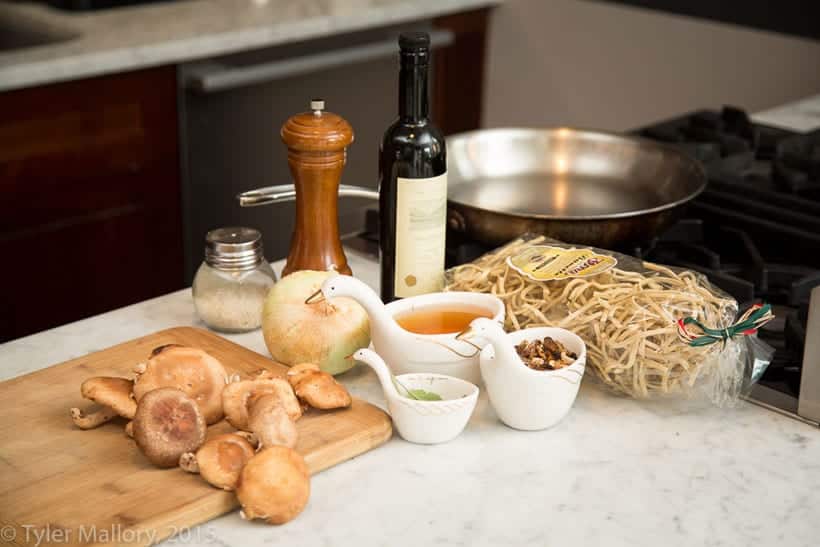
The cinghale, or wild boar, is both an emblem of Tuscany, and a delicacy of sorts; however, they can quickly become pests. When they forage the woods, these creatures are happy enough, but when a boar tears through vineyards and village gardens, they can create havoc within moments.
Boar hunting season is in the fall through early winter, leading to lovely rich wintertime sauces – though properly processed and stored, the meat is now used year round. Wild boar is much leaner than commercially raised pigs; the meat is dark and slightly gamey (though not overwhelmingly so), and it has a sweet, rich, almost nutty tone.
Accented with native Tuscan herbs including sage and rosemary, the complexity of the meat shines.
When we returned to Italy in May of 2015, I knew that I would be eating whatever boar options I could find – proper cacciatore cinghale, pasta with boar sauce, even wild boar steak, if I could get my hands on it. We found heaven itself at a small trattoria in Orvieto – technically in Umbria, but close enough, right?
Trattoria da Carlo, hidden on a quiet courtyard down a tiny alleyway off the Piazza del Popolo, offered a sumptuous, rich bowl of Nostra al Cinghale Bianco – white boar pasta.
White boar pasta! I was so accustomed to the traditional tomatoey sauce – immediately I was intrigued and ordered a portion. Perfection!
Made with a base of very slowly cooked onions, some porcini mushrooms, sage and rosemary, and then finished with white wine and just a spot of milk, a white sauce lets the rich flavors of the meat really shine through.
When paired with perfectly al dente tagliatelle and finished with a sharp pecorino, the sauce hugs the noodle, and the various flavors of herbs, boar, mushroom, pasta and cheese harmonize beautifully.
It was the first dish I made when I arrived back home – and has gone permanently on our “favorites” list. This is a sauce that takes time, so get ready to spend a wonderful hour and a half stirring, chatting, and enjoying some wine while your kitchen fills with the rich scents of Italy.
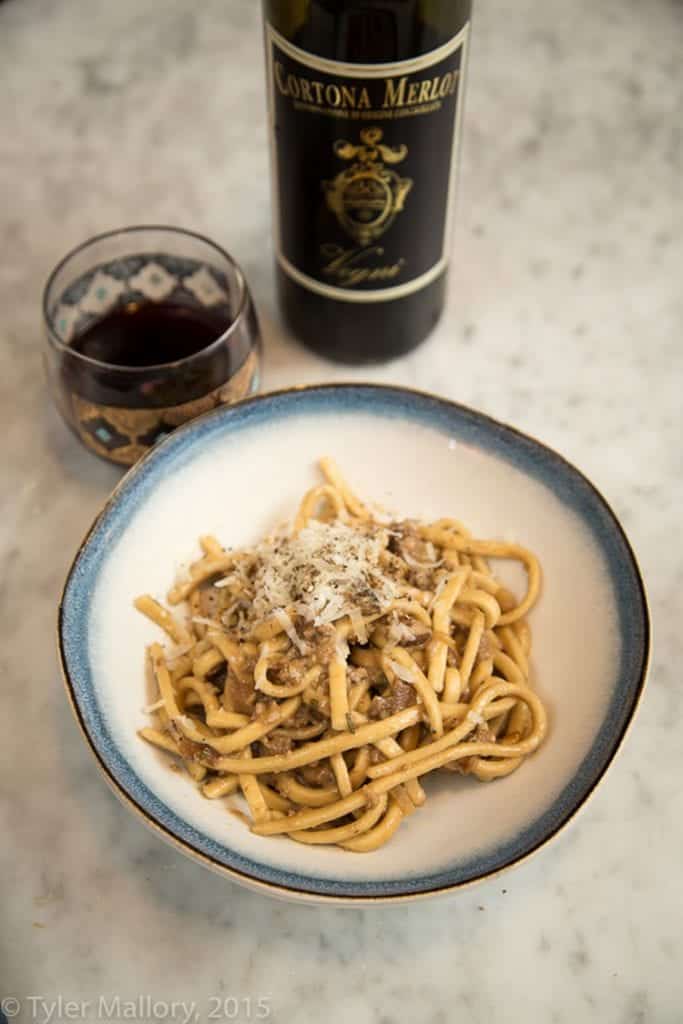
Some notes: the recipe below is adapted from trial and error and Le Passioni di Antonella.
This recipe is pretty slow and languorous until the end, when suddenly everything seems to happen all at once. Isn’t that always the case? When I prep everything in advance, it helps make the process smooth.
In Chicago, where I am writing this, we are able to find ground wild boar at the local Mariano’s grocery store; sometimes specialty butchers may carry it, and you can order it online. If you can’t find wild boar, a heritage raised organic ground pork will come close in flavor, but there’s really no substitute.
The final addition of oil and cooked pasta water back to the pot helps create a rich, flavor infused noodle – don’t skip it!
If you can find pecorino di noce, or pecorino di fiano, try that: those are aged in walnut leaves and hay, respectively, and have a sharp bite not found in american pecorinos.
A well chilled gavi or verdicchio is a perfect crisp accompaniment to the rich flavors. Alternatively, a Tuscan red is also a beautiful marriage!
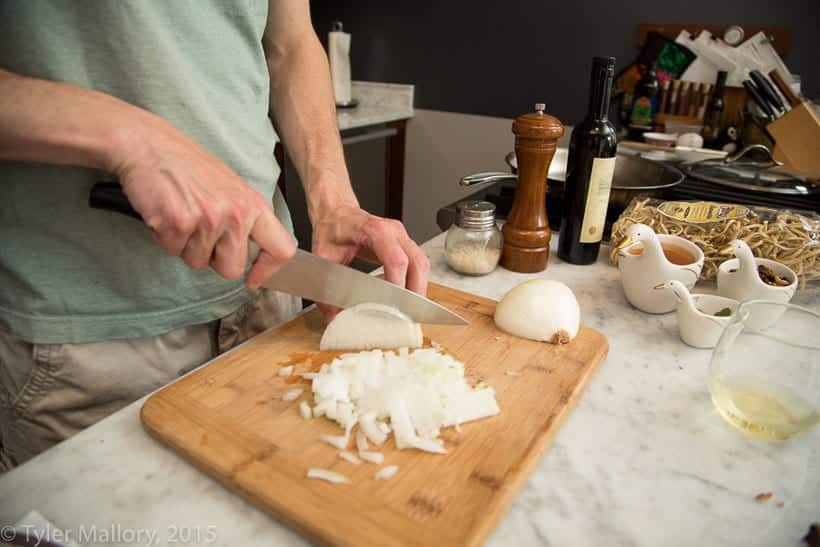
Ingredients:
- 16 oz fresh or dried tagliatelle, chitarra, bavette or similar wide, toothsome pasta (fresh made pasta is always the best, but we found the Flora Bavette Porcini Pasta to be a phenomenal alternative when time crunched!)
- 2 cloves garlic, crushed
- 1 sprig rosemary, finely chopped
- 1 teaspoon chopped thyme
- 8 sage leaves, finely chopped
- ¼ cup dry red wine
- 1lb ground wild boar
- 2 tablespoons Extra Virgin Olive Oil, + extra for pasta water
- 2 Tablespoons butter
- 1 med yellow onion, chopped very fine – approx ⅛” pieces
- ½ cup dried, torn porcini mushrooms
- ¼ lb fresh shitake mushrooms
- ½ cup hot water
- 1 cup vegetable or chicken stock
- 1 cup dry white wine
- ⅓ cup milk or cream
- sea salt or kosher salt
- fresh cracked pepper
- ¼ to 1/2lb pecorino cheese, grated
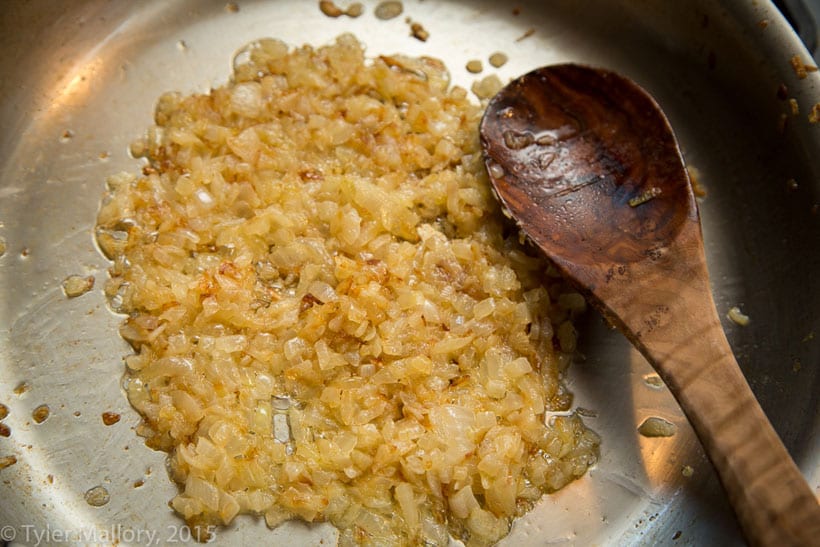
Method:
In a covered bowl, marinate wild boar for at least 2 hours, or overnight, with garlic, rosemary, thyme, half the sage, and red wine.
Heat a large saucepan on med-high heat; add the oil and butter; when melted, add the onions, and turn heat to low. Sweat the onions on a very low heat for about an hour, stirring every 5-10 minutes, allowing the juice to release, creating rich flavor. You can add a spoonful or 2 of broth if you feel it’s getting too dry. Turn the heat up at the end for about 8 minutes to get a little caramelization.
While the onions are cooking, reconstitute the dried mushrooms with hot water; cover and let sit at least 15 minutes.
Remove onions from the pan. Turn the heat to med-high, add a drop of olive oil, and saute the fresh mushrooms, about 8 minutes. Return onions and any residual juice to the pan.
Use a fork to tear the meat into smaller pieces, and add to the pan, cooking on low heat, about 8 minutes, until cooked through but not browned.
Add remaining sage, reconstituted mushrooms, the mushroom water, white wine, and remaining broth to the pan. Add a pinch of salt and 3-4 cracks of pepper (or to taste). Raise heat to medium, and stir slowly as the liquid reduces. When the liquid is reduced by about ½ (approximately 8 minutes), add the milk and continue to stir; reduce heat if needed.
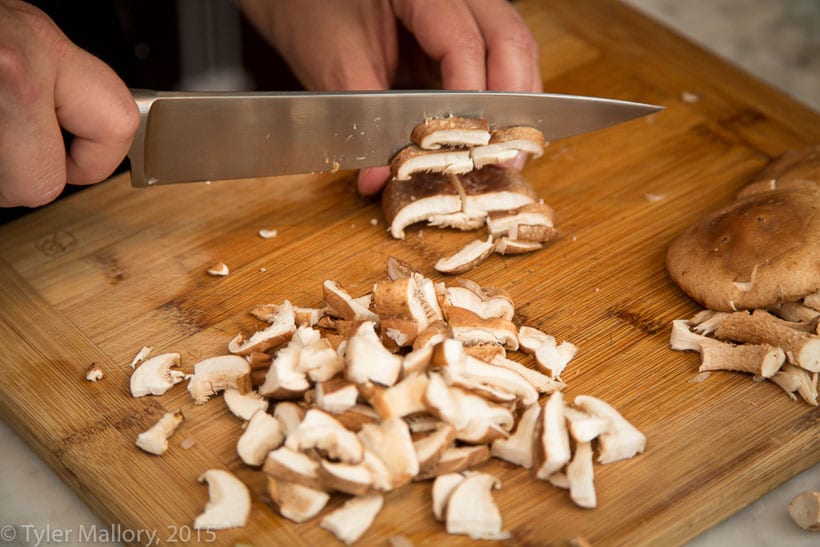
Prepare pasta water: in a large pot, bring to a boil about 1 quart fresh cold water, 1 teaspoon salt, and a splash of olive oil – a proper pasta water has the taste of the sea. Add more water if needed to properly cook your choice of pasta. Cook pasta according to packaging or experience: it should be al dente, with a hint of resistance when bit through; this is usually 5-8 minutes. When the pasta is ready, ladle about 1 ½ cups pasta water into a separate bowl before draining the pasta.
Return pasta back to the pot and return over medium heat. Add a splash of olive oil, ¼ cup pasta water, and stir rapidly. Add the ragu, stirring to coat the pasta thoroughly; add more pasta water, about ¼ at a time, if you would like a “wetter” sauce. Remove from heat.
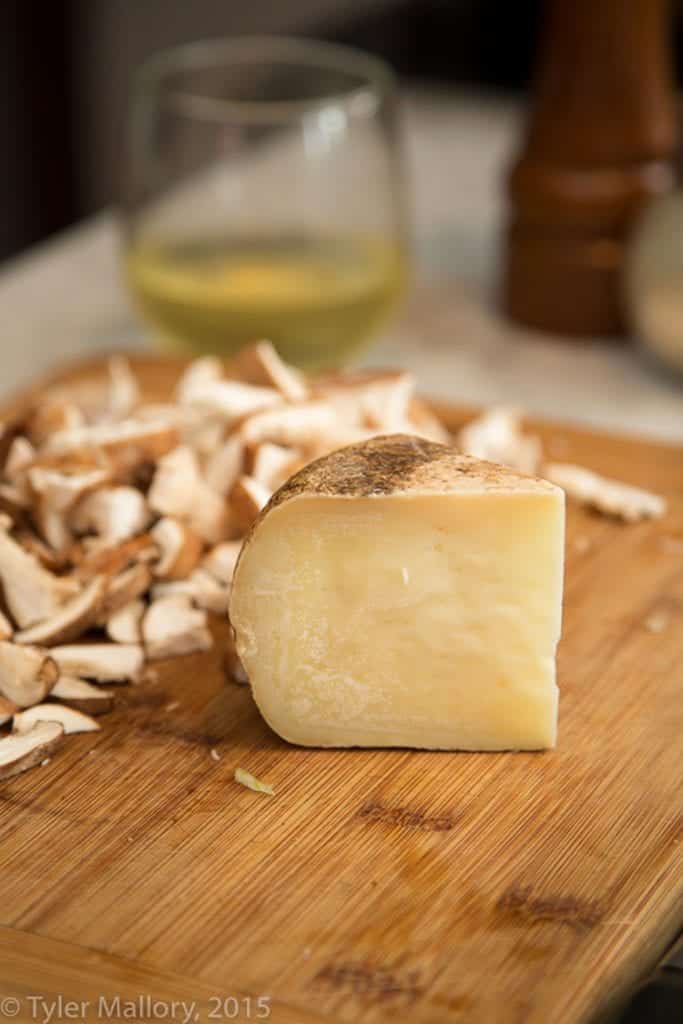
Plate with a sprinkle of shredded pecorino, a finish of sea salt, and a crack of pepper.
Buon appetito!
*Author’s Note: yes, 20km is almost laughable for a bike ride – especially now that this same author has cycled 100 miles in Death Valley. However – back then, with the equipment we had and the heat wave we were in – it was tough! Trust me! Thankfully, the ride home was literally downhill most of the way!
All Photos by Tyler Mallory, 2015
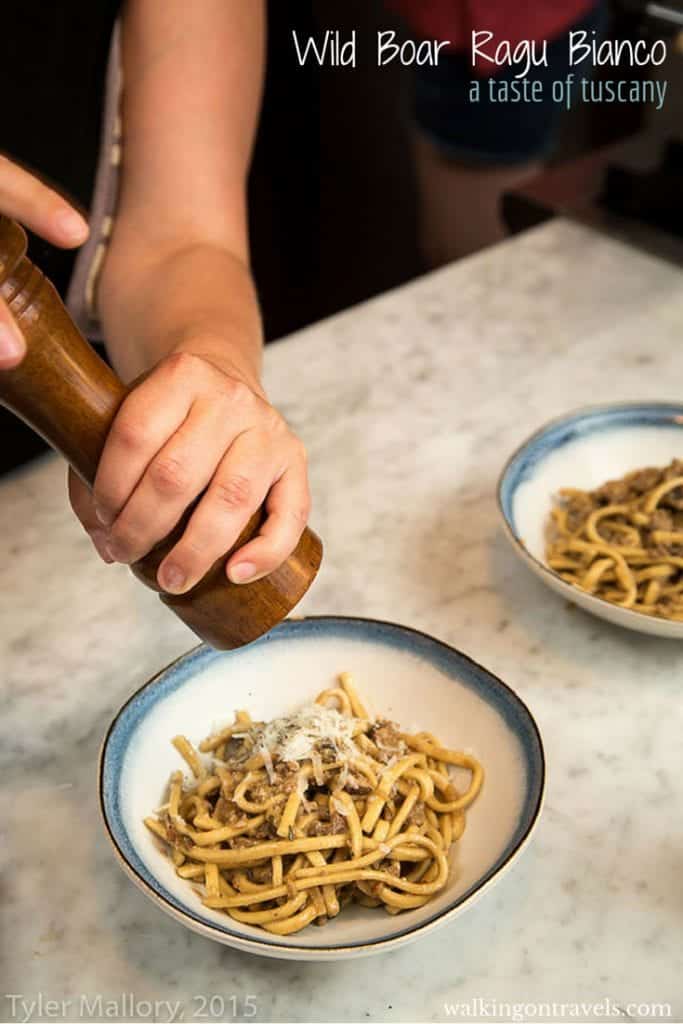


I wish I could jump into the computer screen. This dish looks amazing!!! Hats off to the photographer bc I am drooling 😉 Yummy! I pinned this one for later
Thanks for the wonderful comment, Mama Munchkin! The photographer is actually my husband, featured slicing onions (um, clearly, I took that pic). You can see more of his work at tylermallory.com
I just came back from Italy lasta week. I ate in san geminiano this delicious picci white ragu pasta and was amazing and I want to make it asp in my home. Thanks for the recipe.
I’m so glad you enjoyed cinghale there and are trying it here! We recently made it with bison, which is also a super meat to include in the recipe – it has a similar gamey sweetness and pairs beautifully with a tuscan red. Buon appetito!
I just returned from my first time to Europe and one week in Tuscany. I ordered wild boar sauce as it seemed interesting. The waiter was very happy with my unknowledged selection. After one bite I understood why. I am back home in Colorado and could not wait to research this recipe to relive my wonderful experiences in Tuscany. I loved your writing and illustrations. Thank you for sharing your experience!
I’m so glad that you tried that and enjoyed it! It’s been one of my absolutely favorite foods for the longest time. Hot tip: we recently discovered that bison is actually a super alternative to wild boar – my local store stopped carrying boar, but the bison has a similar gamey sweetness.
Thank you so much for the recipe we visited San Gimignano last year and I can tell you that this recipe tasted exactly like the ones that we had in the old city…. just fabulous !
I’m so glad you enjoyed!!
My 2 hunter sons each brought home a wild boar so we are swimming in meat! We do not have any ground boar, but could I use cubed loin meat instead? What would the cook time be? Thanks.
How many servings is this recipe for? Primi or main?
Hi there Eric,
My rule of thumb is about 1/4lb pasta per adult for a main, so this would make 4 ample servings, but it all depends on how you plate! You could easily use the same recipe as a primi for 6-8. It also saves well; if I make it just for my family, we usually have leftovers for lunch the next day.
hi there. how much wild boar do you need and should it be ground ( minced) . Wasnt it recipe ingredients. sue
Thanks for the question! I list 1 pound (lb) ground wild boar in the recipe, but you can use as much or as little as you prefer, pending your appetite for protein. If you happen to have access to actual boar meat on bone, you may want to consider slow cooking it like a pork shoulder and then incorporating shredded boar into a sauce….. In general I think I have an unofficial “rule of thumb” to use about a pound of meat per pound of dried pasta (assuming each adult will eat 1/4 to 1/3 of a pound of pasta).
buon appetito – let me know how it goes!
-tai
I’ve been following this recipe for a few years now.
It is truly a perfect way to relive having RAGÙ DI CINGHIALE.
Thank you so much for doing this research and posting this recipe
I’ve made this three times over the past year– LOVE IT 💕 This is “comfort-crave” food at its best 😊
Do you discard the red wine marinade and herbs? or add it in when you add the meat?